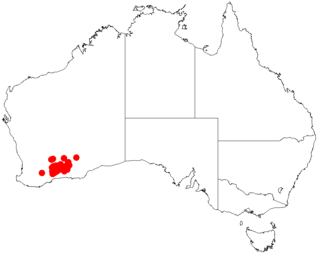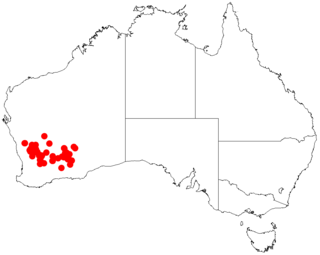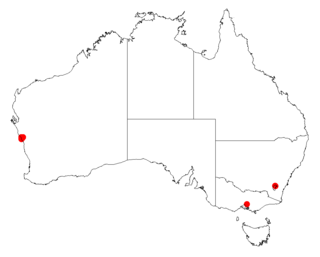
Acacia pulchella, commonly known as prickly moses or western prickly moses, is a shrub in the family Fabaceae. Endemic to Western Australia, it is one of the most common shrubs of the bushland around Perth and in the Darling Range.

Acacia glaucoptera, commonly known as flat wattle or clay wattle, is a species of Acacia which is endemic to the south-west of Western Australia.

Acacia desertorum is a shrub belonging to the genus Acacia and the subgenus Juliflorae that is endemic to western Australia.

Acacia barbinervis is a shrub belonging to the genus Acacia and the subgenus Phyllodineae endemic to Western Australia.

Acacia cupularis, commonly known as the Coastal Umbrella Bush, is a shrub belonging to the genus Acacia and the subgenus Phyllodineae that is endemic to southern parts of Australia.

Acacia erinacea, also known as prickly wattle, is a shrub belonging to the genus Acacia and the subgenus Phyllodineae that is native to Western Australia.

Acacia gonophylla, also known as rasp-stemmed wattle, is a shrub belonging to the genus Acacia and the subgenus Phyllodineae that is endemic to south western parts of Australia.

Acacia poliochroa is a shrub belonging to the genus Acacia and the subgenus Phyllodineae that is endemic to south western Australia.

Acacia prainii, commonly known as Prain's wattle, is a shrub or tree belonging to the genus Acacia and the subgenus Phyllodineae endemic to Australia.

Acacia profusa is a shrub of the genus Acacia and the subgenus Phyllodineae that is endemic to south western Australia.

Acacia sphacelata is a shrub of the genus Acacia and the subgenus Phyllodineae that is endemic to south western Australia.

Acacia colletioides, commonly known as wait-a-while, pin bush and spine bush, is a shrub of the genus Acacia and the subgenus Plurinerves that is native to Australia.

Acacia densiflora is a shrub of the genus Acacia and the subgenus Plurinerves that is endemic to an area of south western Australia.

Acacia dissona is a shrub of the genus Acacia and the subgenus Plurinerves that is endemic to an area of south western Australia.

Acacia inceana is a shrub or tree of the genus Acacia and the subgenus Plurinerves that is endemic to south western Australia.

Acacia oswaldii, commonly known as boree, umbrella wattle, umbrella bush, whyacka, middia, miljee, nella and curly yarran, is a shrub or tree of the genus Acacia and the subgenus Plurinerves.

Acacia sclerophylla, commonly known as the hard-leaf wattle, is a shrub of the genus Acacia and the subgenus Plurinerves and is endemic to southern parts of Australia.

Acacia sulcata is a shrub of the genus Acacia and the subgenus Plurinerves that is endemic to an area of south western Australia.

Acacia empelioclada is a shrub of the genus Acacia and the subgenus Pulchellae that is endemic to an area along the south coast of south western Australia.

Acacia guinetii, commonly known as Guinet's wattle, is a shrub of the genus Acacia and the subgenus Pulchellae that is endemic to a small area along the coast of western Australia





















